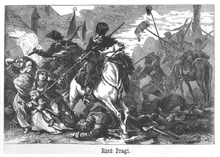
Warsaw, officially the Capital City of Warsaw, is the capital and largest city of Poland. The metropolis stands on the River Vistula in east-central Poland. Its population is officially estimated at 1.86 million residents within a greater metropolitan area of 3.27 million residents, which makes Warsaw the 7th most-populous city in the European Union. The city area measures 517 km2 (200 sq mi) and comprises 18 districts, while the metropolitan area covers 6,100 km2 (2,355 sq mi). Warsaw is classified as an alpha global city, a major cultural, political and economic hub, and the country's seat of government. It is also capital of the Masovian Voivodeship.

Praga-Południe, also known by its anglicized names Praga-South, Praga South, and South Praga, is a district of the city of Warsaw, Poland located on the east bank of the Vistula River. It consists of Grochów, Gocław, Kamionek and Saska Kępa.
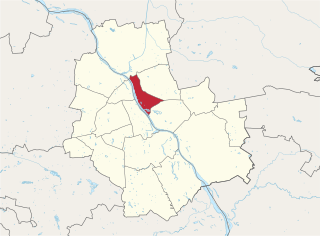
Praga-North, also known as North Praga, Praga North, is a district of the city of Warsaw, Poland, located in the central part of the city.

Kamionek is a neighbourhood in Warsaw, located on the right bank of the Vistula river. It is the birthplace of the polish statesman Roman Dmowski. Formerly a village, in the 19th century, with the beginning of the Industrial Revolution in this part of the Russian Empire, it was transformed into a textile industry center. Today it is part of Praga Południe, and most of its factories closed after the fall of the communism in Poland. It borders the Skaryszew Park and Kamionek Lake to the south, Grochów to the east, and Praga to the north.
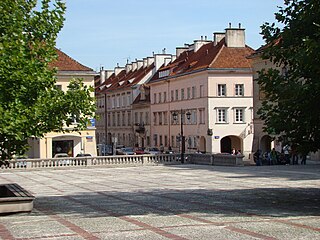
Mariensztat is a historic neighbourhood along the Vistula river in central Warsaw, the capital of Poland. Situated between the riverbank and the UNESCO-protected Old Town, Mariensztat is part of the larger Śródmieście (Downtown) borough and is one of the city's smallest neighbourhoods.

Saska Kępa is a neighbourhood in Warsaw, Poland, part of the Praga Południe district, with a population of over 40.000 inhabitants. It is also the home to one of Warsaw's largest urban parks, the Skaryszew Park. The neighbourhood is mostly occupied by semi-detached suburban houses and villas.

The Diocese of Warszawa-Praga is a Latin Church diocese of the Catholic Church located in the east part of Warsaw (Praga) in the ecclesiastical province of Warszawa in Poland.

Warszawa Wschodnia, in English Warsaw East, is one of the most important railway stations in Warsaw, Poland. Its more official name is Warszawa Wschodnia Osobowa. It is located on the eastern side of the Vistula river, on the border of the Praga-Północ and Praga-Południe districts, on the Warsaw Cross-City Line. It serves all trains passing through the larger Warszawa Centralna and Śródmieście stations which stop or terminate at Wschodnia station. It is one of the busiest railway stations in Poland, with over 800 daily trains.

St. Florian's Cathedral, more formally known as the Cathedral of St. Michael the Archangel and St. Florian the Martyr, is a Roman Catholic church and minor basilica, dedicated to St. Florian. The church is located at 3 Floriańska Street in Praga-Północ district of Warsaw.
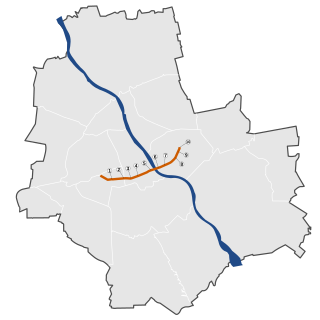
The Łazienki Route is a road in Warsaw, Poland. It connects the center of Warsaw with the east-bank of Warsaw. It was built from 1971 to 1974.

Ząbkowska Street is one of the oldest streets in Warsaw, Poland, located in the Praga-Północ district. It runs east from Targowa Street and is around one kilometre long. Considered one of the most interesting tourist destinations, it is famous for historical buildings, namely tenement houses that were built at the turn of the 20th century.

Skaryszew Park is an urban, monumental park located in the Praga-Południe district of Warsaw, Poland. The park was designed and created by Franciszek Szanior in 1906.

Romuald Kamiński is a Polish Roman Catholic priest who has served as bishop of Warszawa-Praga since 2017. He was the auxiliary bishop of Ełk between 2005 and 2017.

Kazimierz Romaniuk is a Polish Catholic prelate, and professor of biblical studies. In 2004, Romaniuk became the bishop emeritus of the diocese of Warszawa-Praga. He was previously the rector of the Higher Metropolitan Seminary and the Academic Study of Catholic Theology in Warsaw, the auxiliary bishop of Warsaw, and the diocesan bishop of Warsaw-Praga.

Stanisław Kędziora was a Polish Roman Catholic bishop and doctor of theology. He served as auxiliary bishop of the Archdiocese of Warsaw from 1987 to 1992 and as auxiliary of the Diocese of Warszawa-Praga from 1992 to 2011.

Żerań is a northern suburb of Warsaw, Poland, situated in the Białołęka district. It is noted for the Żerań Power Station. The area borders with the Vistula River, the Praga-Północ district and the Tarchomin, Różopol, Konstantynów and Annopol housing estates.
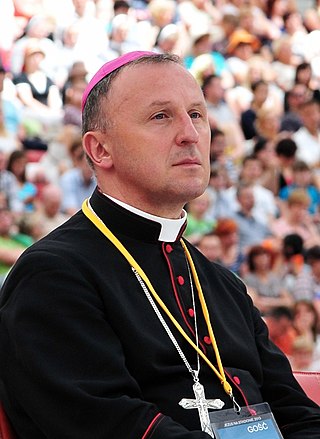
Marek Solarczyk is a Polish Roman Catholic prelate, Bishop-elect of Radom.

2B Jerzego Waszyngtona Avenue high-rise is a modernist residential high-rise in the city of Warsaw, Poland, located at 2B Jerzego Waszyngtona Avenue. It was designed by architect Marek Leykam, and built in 1963. It is an early example of modernist architecture in Poland, and upon construction, it was the first high-rise built on the right bank of Vistula river in Warsaw, and the first building in the city, with at least one wall with fully glass-covered elevation.

Zawady is a neighbourhood, and a City Information System area, in Warsaw, Poland, located within the district of Wilanów.


